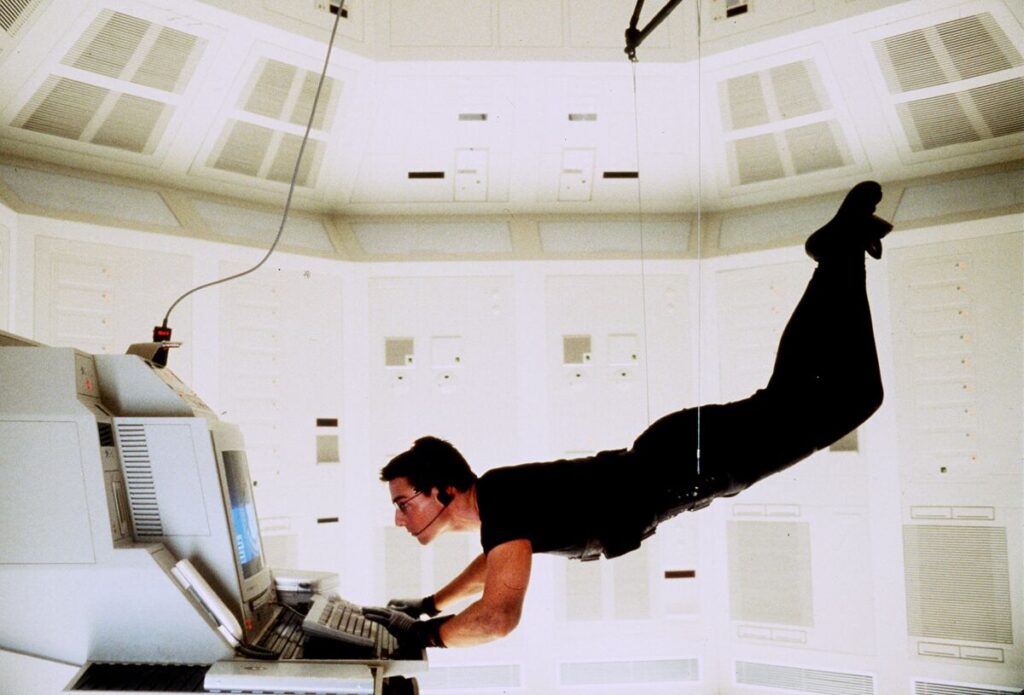There may be only one way to break into a sound-sensitive, temperature-monitored vault at CIA headquarters, but there are many, many different ways to qualitatively rank the “Mission: Impossible” movies.
Which one has Tom Cruise’s best running scene? (“Mission: Impossible — Fallout.”) His best hair? (“Mission: Impossible 2.”) His most sweat-triggering, vertigo-inducing set piece? (“Mission: Impossible — Ghost Protocol,” easily.)
Or you could just list all seven movies — including the soon-to-be-released “Mission: Impossible — Dead Reckoning Part One” — in order from best to worst, as we’ve done here with the help of Times’ movie reviews over the years.
Much of this comes down to taste in directors: What’s more impressive, the sleek visual elegance of Brian De Palma, the fiery bombast of John Woo or the overall consistency of Christopher McQuarrie, who has steered the last three movies?
We’ll check back in on that when McQuarrie’s “Dead Reckoning Part Two” is released next year. For now, here are our picks.
1. ‘Mission: Impossible’ (1996)
Tom Cruise stars in “Mission: Impossible,” the movie that launched a franchise.
(Murray Close / Paramount Pictures)
The first film, starring Cruise as the indefatigable, cable-dropping secret agent Ethan Hunt, did not get the glowing reviews expected of a multimillion-dollar franchise. But the reception, coupled with astounding box-office receipts ($457.6 million globally, to be exact) was hot enough to launch a decades-spanning juggernaut — even if our reviewer Kevin Thomas thought the adaptation inspired by the TV series was “mercifully pretty simple.”
“[A]t any given moment in super-secret agent Cruise’s mission, it is impossible to say with any confidence what’s going on. So you should approach this like the most convoluted Chinese kung fu movie: Let it wash over you and don’t try to figure anything out. Proceed in the reasonably safe assumption that good will surely triumph over evil and that everything eventually will become clear, or at least fairly so.”
Read the review: ‘Mission’: Hang tight : Superb stunts and suspense star in an ‘Impossible’ story
2. ‘Mission: Impossible — Fallout’ (2018)
Tom Cruise as Ethan Hunt in “Mission: Impossible — Fallout.”
(Paramount Pictures)
More than 20 years later, former Times critic Kenneth Turan didn’t see much improvement in the films plot-wise (“the storyline’s essential function is to serve as an action sequence delivery system”), but there was plenty to be expected from — and still be blown away by — Cruise’s first-person stunt work and supporting cast.
“McQuarrie has brought back numerous familiar characters from the entire range of previous films, including Ving Rhames, sidekick Luther since the 1996 original, wife Julia (Michelle Monaghan) from ‘Mission: Impossible III’ and more recent ‘Rogue Nation’ additions such as fellow secret agent Ilsa Faust (Rebecca Ferguson) and implacable anarchist threat Solomon Lane (Sean Harris).
“Though it seems like an odd analogy for such an action-heavy film, these familiar faces, and the emotional connections we’ve formed with their characters over the years, make ‘Mission Impossible — Fallout’ the thriller version of comfort film. It’s something we can return to with complete confidence in what we’re getting into.”
Read the review: Tom Cruise returns, crazy stunts and all, in ‘Mission: Impossible — Fallout’
3. ‘Mission: Impossible — Rogue Nation’ (2015)
Tom Cruise tests the laws of physics in “Mission: Impossible — Rogue Nation.”
(Christian Black / Paramount Pictures)
Turan believed Cruise by this point in the franchise could have phoned in his performance as the intrepid secret agent, but the actor absolutely does not. That becomes apparent in a seemingly impossible hallmark in the opening sequence featuring Cruise dangling from a departing aircraft by his fingertips and setting a new standard even for the self-one-upping action star.
“Both in front of and behind the camera, ‘Rogue Nation’ has been smoothly made by people who know just how to get entertainment business done and have often worked with Cruise before.
“That is very much true of filmmaker Christopher McQuarrie, who was a writer on two Cruise ventures (‘Valkyrie’ and ‘Edge of Tomorrow’) and directed the actor’s ‘Jack Reacher’ venture. Teaming up with cinematographer Robert Elswit and production designer Jim Bissell, both of whom worked on the earlier ‘Mission: Impossible — Ghost Protocol,’ McQuarrie is adept at keeping things moving and has overseen two areas where ‘Rogue Nation” stands out from the crowd.”
Those two areas are physical action and foregrounding a glamorous woman of mystery who’s just as capable as Cruise’s iconic protragonist: Swedish actress Rebecca Ferguson, Turan said, “brings a bit of unexpected maturity and substance to the role of the inscrutable Ilsa Faust, an individual who is fully Hunt’s equal, and then some, in derring-do.”
Read the review: Once again, Tom Cruise accomplishes the near-impossible in ‘Rogue Nation’
4. ‘Mission: Impossible — Dead Reckoning Part One’ (2023)
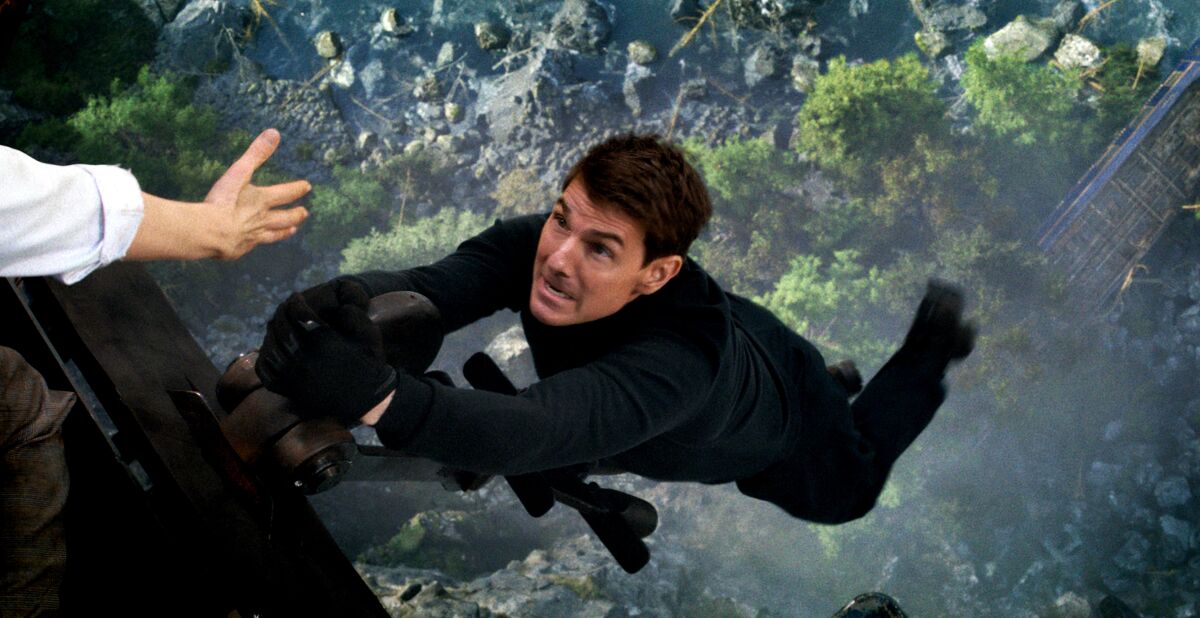
Tom Cruise in “Mission: Impossible — Dead Reckoning Part One.”
(Paramount Pictures)
Times film critic Justin Chang thinks the seventh and latest installment is “ludicrously entertaining and even more ludicrously titled,” but Cruise — hailed as the cinematic savior of the post-pandemic era — dutifully “suffers for our pleasure like no one else” and tempers his “usual superhuman self-seriousness with lightness and wit.”
“The quality of the action here is, for the most part, more fluid and satisfying than jaw-dropping; there’s nothing here to rival De Palma’s snazziest set pieces, or Ethan’s vertiginous climb up the walls of the Burj Khalifa in ‘Mission: Impossible — Ghost Protocol’ (2011), or his men’s room demolition derby in 2018’s ‘Fallout.’
“But McQuarrie’s typically fastidious writing (undertaken this time with Erik Jendresen) makes up for whatever his direction [in his third ‘M:I’ production] may lack in sheer verve. And he does pull off one major cinematic coup: a triumphantly visceral, spatially disorienting, pull-out-the-stops ripsnorter of a climax that seems designed to ensure that no one dares set a movie aboard the Orient Express ever again, for fear of inviting unfavorable comparisons.”
Read the review: Tom Cruise is out to save the movies. Is ‘Mission: Impossible 7’ enough?
5. ‘Mission: Impossible — Ghost Protocol’ (2011)
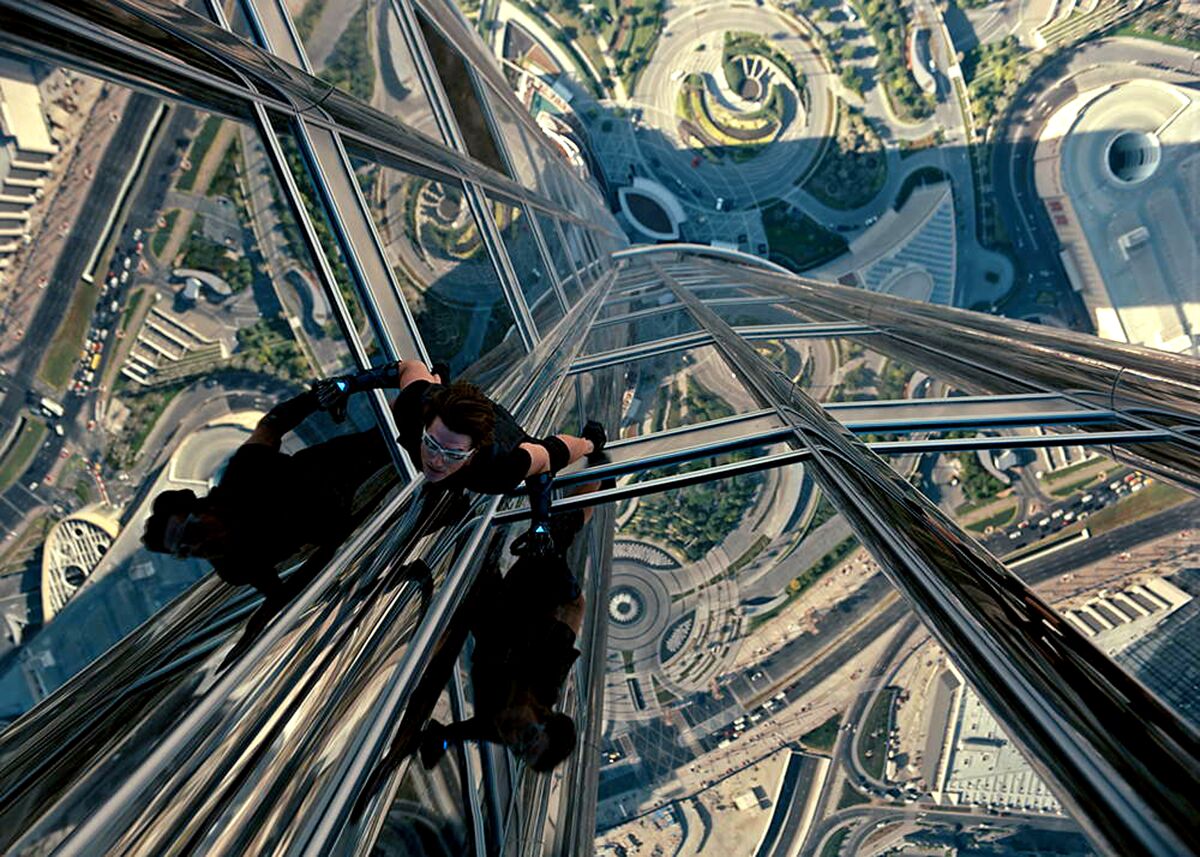
Tom Cruise plays Spider-Man … er, Ethan Hunt … in “Mission: Impossible — Ghost Protocol.”
(Paramount Pictures)
The fourth film will forever be associated with Cruise scaling Dubai’s Burj Khalifa, the world’s tallest building, and that’s likely part of the reason Turan described the film as “high anxiety with a vengeance.” He also welcomed director Brad Bird’s vision for the franchise as the filmmaker made his live-action debut after directing three exceptional animated films ( “Ratatouille,” “The Incredibles” and “Iron Giant”).
“Bird has done a stylish and involving job here, turning in an entertaining production that’s got considerable visual flair, especially in its action-heavy Imax sections. Many of ‘Ghost Protocol’s’ key action sequences were filmed with that 65 mm camera. There are only 27 minutes of Imax footage in the film, but every one of those minutes counts, which is one reason why Paramount chose to open this film in Imax theaters Friday, five days before its general release. For a film with these kinds of visuals, it must have been an easy choice.
“Bird also brought a touch of playfulness to the proceedings in moments like a self-destructing phone booth that refuses to self destruct. If ‘Ghost Protocol’ doesn’t display as much individualism as Bird’s animated features, that likely wasn’t in the cards with a tent-pole series like this.
“What is in those cards is another unswerving performance by Cruise, whose onscreen commitment to the role is key to making these two-fisted tales — not to mention lines like ‘nobody leaves this hotel alive’ — believable.”
Read the review: ‘Mission Impossible — Ghost Protocol’ review: Cruise hits highs
6. ‘Mission: Impossible III’ (2006)
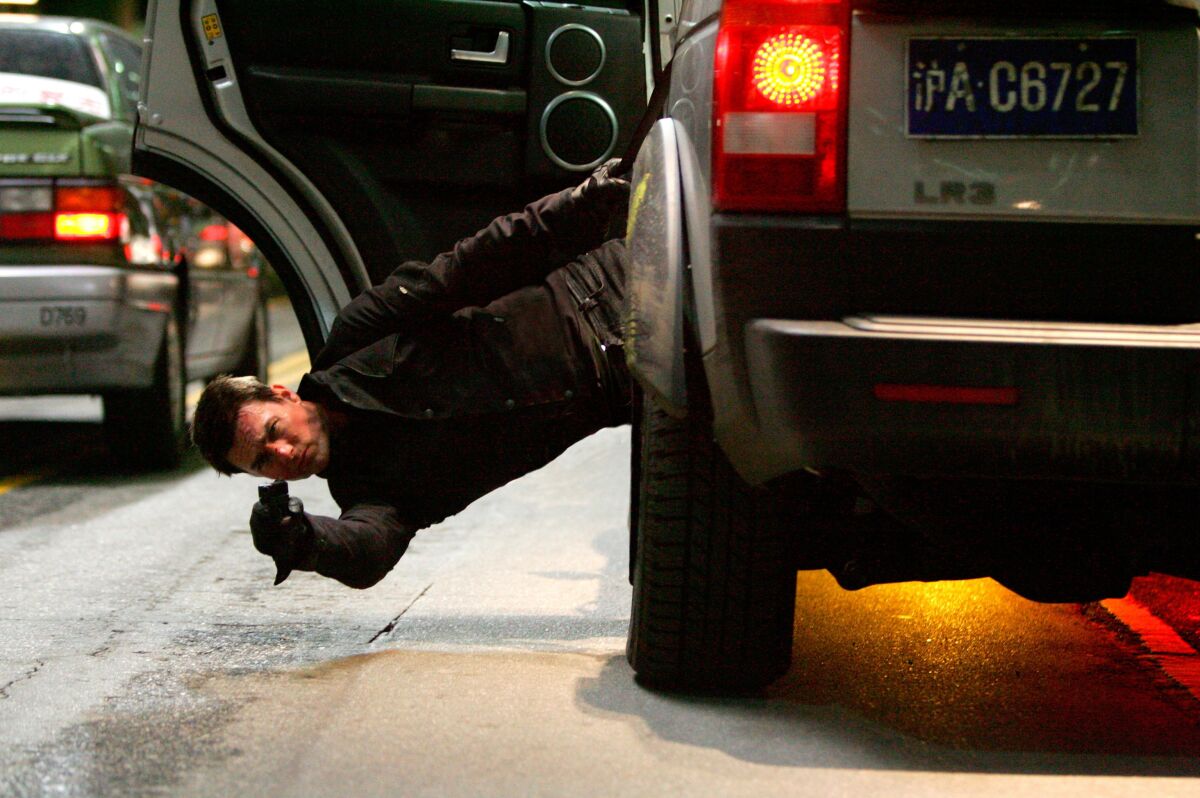
Tom Cruise sends a clear “back off” message in “Mission: Impossible III.”
(Stephen Vaughan / Paramount Pictures)
Under the auspices of writer-directer J.J. Abrams — best known at the time for his work on acclaimed television dramas “Alias” and “Lost” — Turan felt that the third chapter in the franchise played “like two consecutive one-hour TV shows, one sort of standard, the other stocked with excitement.”
“Though ‘M:I:III’s’ first hour has its share of action sequences that must have cost the Earth, it can’t completely shake a pro forma feeling, the idea that its main job is to set the scene for the next episode, as it were. In fact, it almost seems as if Abrams and co-writers Alex Kurtzman and Roberto Orci (previously employed, as were many of “M:I:III’s” creative personnel, on “Alias”) are aware of this difficulty and have taken dramatic steps to counteract it.”
But he had plenty of good to say about the villainous, “picture-making performance” of late actor Philip Seymour Hoffman, who played the extremely dangerous black marketeer Owen Davian.
“Good-versus-evil films often rise or fall on the strength of the evildoer. In the Oscar-winning Hoffman, who isn’t counting ‘Twister’ when he says he’s never done an action film before, ‘M:I:III’ has a spectacular actor who delivers deadpan some of the most unnerving speeches in villainy’s history. Hoffman is so proficient in this role that he just about overmatches Cruise and makes the wait until he speaks again in the second half of the film hard to endure with any patience.”
Read the review: Staying a step ahead
7. ‘Mission: Impossible 2’ (2000)
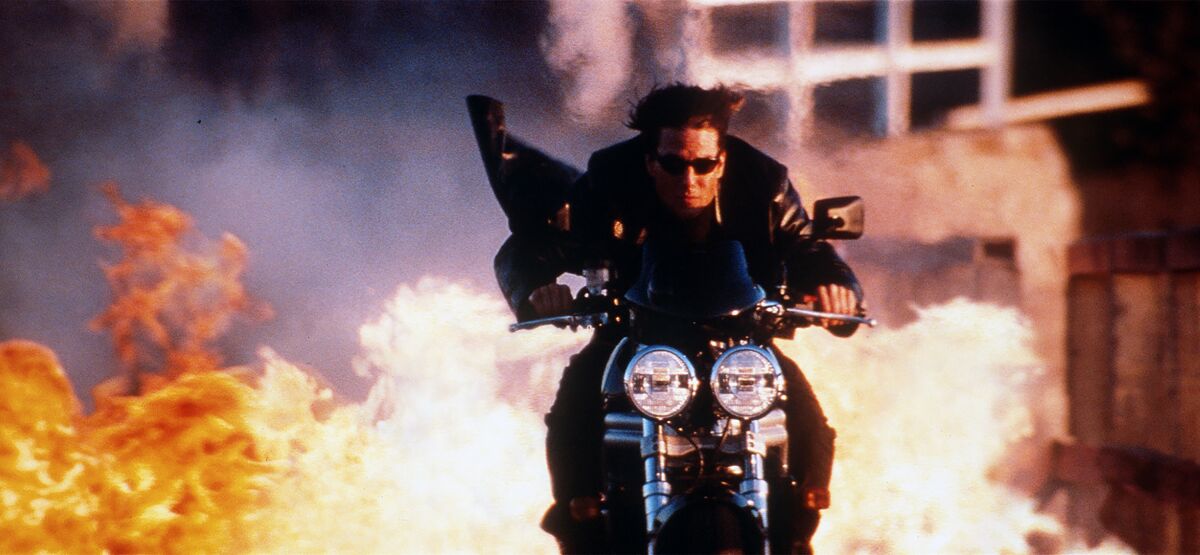
Tom Cruise stars in “Mission: Impossible 2.”
(Paramount Pictures)
Though “M:I-2”is at the bottom of our list, the first sequel — directed by John Woo, maker of “some of the most delirious films films imaginable” — combined Woo’s bad self with Cruise’s star power.
“Even when ‘M:I-2’ is at its exposition-heavy early stages, Woo’s marvelous visual sense is always an asset. Working with cinematographer Jeffrey Kimball, Woo brings a showy flair to the most potentially pedestrian situations. Woo’s films, and this one is no exception, are also characterized by an over-the-top emotionalism that amplifies all feelings to mythological status. The power of film to irrationally transform and exalt is almost a religion to Woo, and another reason why he was the natural go-to guy for this lucrative movie franchise.”
In response to critiques that the original 1996 film was overly convoluted and mechanical, Movieline Magazine critic Stephen Farber — who wrote a feature about the second film for The Times — argued that the studio and director ended up grafting a romantic triangle involving Cruise, a bad girl played by Thandiwe Newton and archvillain Dougray Scott. A triangle, Farber said, that was seemingly lifted from Alfred Hitchcock’s 1946 thriller “Notorious.” At least one Times reader —namely “M:I” screenwriter Robert Towne — vehemently disagreed.
Read the review: An action arsenal
Times staff writers Justin Chang, Josh Rottenberg and Nardine Saad contributed to this story.

